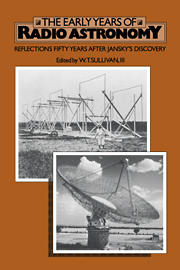Book contents
- Frontmatter
- Contents
- Preface
- THE EARLIEST YEARS
- AUSTRALIA
- The origins of radio astronomy in Australia
- The first decade of solar radio astronomy in Australia
- Early days in radio and radar astronomy in Australia
- Radio sources and the log N–log S controversy
- Early work on imaging theory in radio astronomy
- ENGLAND
- THE REST OF THE WORLD
- BROADER REFLECTIONS
- Biographical notes on contributors
- Name index
- Subject index
The first decade of solar radio astronomy in Australia
Published online by Cambridge University Press: 05 March 2010
- Frontmatter
- Contents
- Preface
- THE EARLIEST YEARS
- AUSTRALIA
- The origins of radio astronomy in Australia
- The first decade of solar radio astronomy in Australia
- Early days in radio and radar astronomy in Australia
- Radio sources and the log N–log S controversy
- Early work on imaging theory in radio astronomy
- ENGLAND
- THE REST OF THE WORLD
- BROADER REFLECTIONS
- Biographical notes on contributors
- Name index
- Subject index
Summary
The first radio emissions detected from outside the earth's atmosphere were those from the Galaxy. It may seem strange, therefore, that so much of the early activity of radio astronomical groups was centred on Solar observations. This early focussing of interest on the Sun followed from war-time studies of radio interference to radar observations; most of the early radio astronomers were radar engineers and were familiar with this work or had taken part in it. Furthermore, they were not astronomers and the Sun as an astronomical object held less fears of the unknown than did the general field of astronomy; this must have had its effect. In Australia the largest of two groups, that in the Radiophysics Laboratory of CSIRO, was composed of physicists and engineers who at the end of the war had been switched from radar to radio astronomy. To them had been added a few physicists from other organizations. A second smaller group was at the Commonwealth Solar Observatory at Mount Stromlo. It included one professional astronomer, C. W. Allen, and an ionospheric physicist, D. F. Martyn.
The Sydney group directed by E. G. Bowen had as its scientific leader J. L. Pawsey, a physicist/engineer of infectious enthusiasm with the interest and ability to contribute in detail to each of the individual research projects being undertaken. His enthusiasm, combined with the youthfulness of the group and the interest inherent in exploring unchartered territory, produced an air of excitement that few scientific groups seem lucky enough to experience. With the eagerness of the young, the scientists shared new ideas with their colleagues as soon as the ideas were formed.
- Type
- Chapter
- Information
- The Early Years of Radio AstronomyReflections Fifty Years after Jansky's Discovery, pp. 113 - 132Publisher: Cambridge University PressPrint publication year: 1984
- 11
- Cited by

